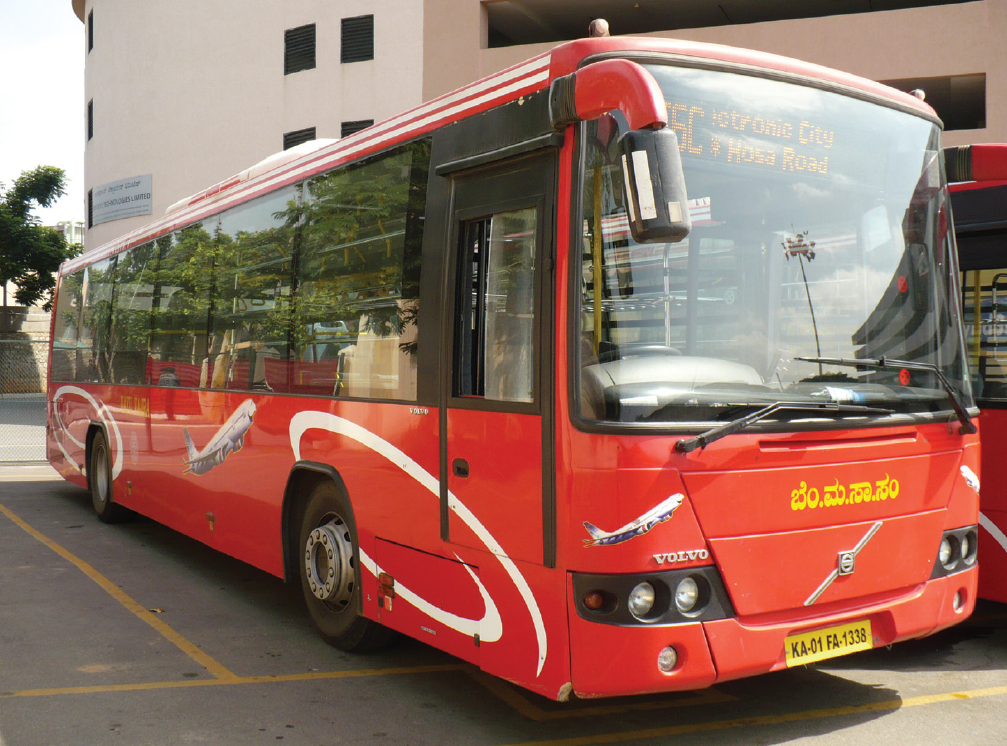
A Volvo B7RLE city bus in service on the streets of Bangalore, the capital of Karnataka
Award-winning ITS initiatives are promising modernisation of bus travel as a key part of development plans for cities of the Indian state of Karnataka.
The Indian state of Karnataka is poised to launch the next stage of a major rollout of ITS technology on its bus network following the August 2012 go-live of an award-winning passenger information system. TheKSRTC has now called for tenders for its INR150 million (US$2.7 million) plans to equip 2000 of its 8000-strong fleet of buses with video cameras, upgraded electronic ticketing and fuel consumption monitoring systems.
The cameras are not just being installed for passenger safety. Says KSRTC managing director Manjunath Prasad: “The cameras will give us live feeds of the number of seats available and alert us to any problems. They will also help us manage the buses better and plug revenue leakages.” The fuel consumption monitoring feature, he continues, will enable assessments of driver behaviour. “We can then correct mistakes by retraining drivers and so improve mileage”. (The Corporation already places heavy stress on driver training – see below).
The project, which is expected to become operational by early 2013, follows on from an earlier phase of ITS deployment, focused on Mysore, the second city of Karnataka, which is a heritage city and centre of a web of major tourist attractions.
Mysore is also developing fast as a satellite of the state capital, Bangalore, 146km to the north east, and emerging as a commercial, industrial (including automotive and engineering) and research hub in its own right.
Mysore’s population, currently just over 800,000, has been increasing at a compounded annual rate of 2.5% for the last two decades, faster than the state of Karnataka as a whole.
Vehicle ownership has doubled over the last 10 years to 350,000, about a fifth of which consists of motorised two wheelers. At the same time, ridership of buses provided by KSRTC is running at a comparatively low level at 13%. The figure reflects an inability to deliver satisfactorily fast services owing to the congested condition of the city’s streets.
Congestion managed down
The vision of Mysore’s current city development plan (CDP) is for a more smoothly-moving community with congestion managed down by projects including completion of an inner ring road, a modern traffic management system and the introduction of bus rapid transit and ‘hop-on hop-off’ tourist shuttles. To help achieve this, a green-oriented• Equipping the city’s 500-strong bus fleet with satellite-based positioning;
• Introduction of LED real-time passenger information displays at the city’s 105 bus stops and six main bus terminals;
• Development of SMS-based information services for passengers on the move;
• Introduction of smartcard-based fare payment.
Mysore is the only one of eight Indian cities covered by the World Bank/GEF SUPT programme where the emphasis of the funding is exclusively on public transport improvement – with passenger and operator information as the main element. KSRTC has taken responsibility for project managing the scheme. From 1 August 2012, an award-winning ITS system will become operational, designed by New Delhi based system engineering and integration specialist
Claimed as the first of its kind in the country, this uses indigenously designed technology for satellite-based vehicle tracking in real-time. Its innovative nature has already won the Best ICT-Enabled Urban Governance Initiative of the Year category of India’s eWorld Awards. These aim to recognise excellence in the adoption of technology in the processes of governance by showcasing noteworthy innovations. Accepting the award at a ceremony in New Delhi in June 2012, CMC chief executive officer R Ramanan said he saw real prospects for the system being adopted in future in other Indian cities.
Among its existing achievements, KSRTC has already introduced to its fleet the
Anywhere anytime
In 2006, KSRTC introduced the country’s first web-based passenger seat reservation service. Its ‘Anywhere anytime advanced reservation’ (AWATAR) system currently has more than 200,000 registered users (including some living outside India), with an average of 600,000 website visits per month. Daily ticket revenues now average six million rupees (US$108,000) and KSRTC claims that the system has delivered measurable financial benefits by attracting travellers from other transport modes.AWATAR now also offers complementary services including hotel bookings, couriers and parcel despatch, and access to the ‘Bangalore One’ public information facility. KSRTC has recently added direct e-booking using debit or credit cards and mobile phones. (In a complementary development, it is offering work to unemployed graduates at its 350 staffed counters, to give them the opportunity to become ticket-selling franchisees).
Another first claimed by KSRTC is its computerisation of driver recruitment using an automated electronic driving system as the basis for candidate selection. This digitally captures the driver’s body mass and uses a web camera to monitor the movement of the training bus through reverse ‘S’ and forward ‘8’ paths, up gradients and into reverse parking. Answers to questions (on traffic signals etc) are entered into a computer, and the system then delivers a result sheet for evaluation.
A final phase of KSRTC’s ITS programme will extend the new system to all of its 8000 buses. This is expected to take 18 months from inception. The Corporation hopes that the end result will be a long-term modal shift away from motorised vehicle use, easing traffic congestion and reducing environmental pollution in towns and cities throughout the state.
Award winning
India’s 2012 eWorld Forum Awards were organised by the Centre for Science, Development & Media Studies, an Indian non-governmental organisation committed to encouragement of ICT for social development; and Elets Technomedia, an Indian research company focusing on public-sector ICT. In a second 2012 trophy gain, KSTRC has won the Association of India Communications Multimedia & Infrastructure’s national telecom award, in the innovation in public service category, for its use of ICT in public transport.













